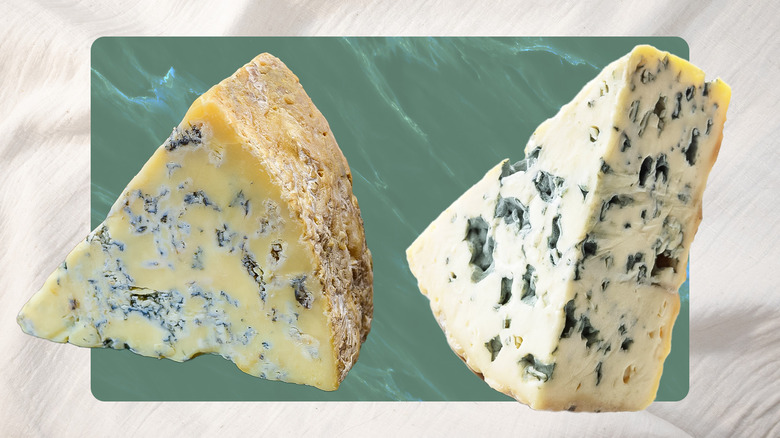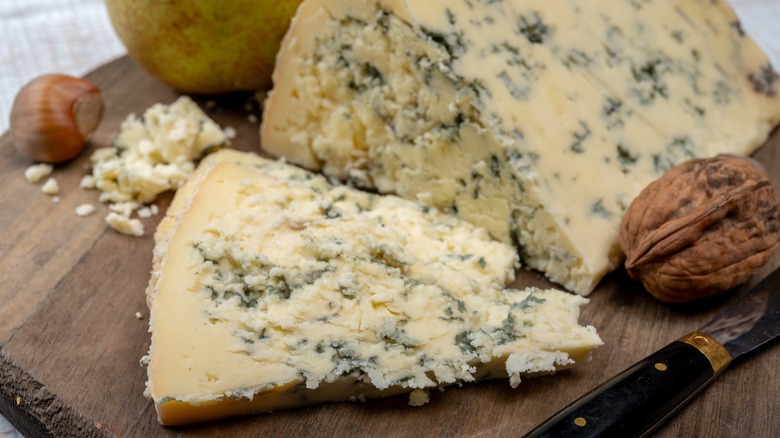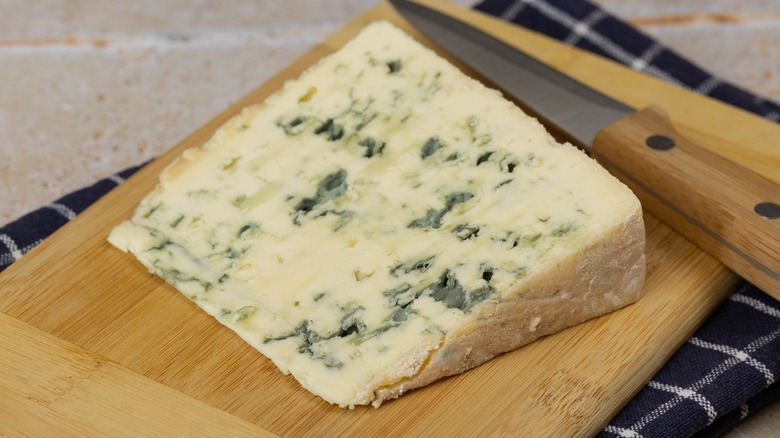The Main Differences Between Stilton And Roquefort Blue Cheese
We may receive a commission on purchases made from links.
Not only can blue cheese add a pungent boost of flavor to dishes and make for some tangy, creamy blue cheese salad dressings, but it also delivers added health benefits in the form of nutrients, probiotics, and calcium. To make blue cheese, mold cultures are added to milk. The cheese is then punctured to introduce air flow and allow the mold to spread, creating its characteristic blue and green veins. For cheese lovers who struggle with lactose, the cultures used to make blue cheese degrade lactose during aging, so this kind of cheese may be an option with less of a negative impact. For many diners, however, the funky taste and smell of blue cheese is off-putting.
But before you swear off all blue cheese, know that there are differences within the family of this unique dairy product. As you head to the store to survey the mounds of cheese waiting to be purchased, we have a few details that may help you choose the type of cheese that is right for your intended recipes. Blue cheeses are easy to spot due to their recognizable specks of blue or green molds, but the tastes of cheeses falling under the naming umbrella can vary significantly. Still, many people believe the myth that all blue cheese is the same. To dispel some of these misconceptions, let's take a look at the differences between two of most popular varieties, Stilton and Roquefort.
What is Stilton blue cheese?
Crumbly, creamy Stilton offers a complex tasting profile with layers of nutty and salty flavors. This cheese is hand-made from cow's milk specifically in England, and not much has changed about the cheese-making process since its conception. Site-specific production has earned English Blue Stilton a special Protected Designation of Origin (PDO), and the final chunks of cheese sold contain no preservative or fillers. To make Stilton, fresh pasteurized milk is dumped into vats along with rennet, cultures, and yeast that encourages the growth of mold.
Upon signs of curdling, the mixture is separated and the whey is removed before the creamy concoction is salted, milled, and placed into molds. These molds are set onto shelves and rotated by careful workers who ensure that the curd doesn't flatten and the flaky texture that Stilton is known for is retained. After several days, the curd is pressed and smoothed by hand before the cheese is pierced and left to age for at least another month. At the nine-week point, Stilton is mature enough to distribute and sell.
Before the cheese is sold, however, it is graded by experts who assess its quality. If the cheese fails to pass inspection, it won't be labeled with the Stilton name and instead will simply be marked as "blue cheese." Compared to Roquefort, Stilton is more mild in taste and is often served as dessert, since this cheese pairs best with sweet flavors like honey, fresh apricots, and dessert wines. Alternatively, Stilton can be placed on top of crackers or toasted pita bread for snacks and pre-dinner nibbles. It's definitely one of the best types of cheese to splurge on if you want to try something different.
What is Roquefort blue cheese?
Made from unpasteurized sheep's milk, French Roquefort is a creamy and crumbly but semi-hard blue cheese with a zippy palate. Speckled with dark blue and green lines, Roquefort is ivory in color, but the longer the cheese matures, the more vivid its darker colors grow. Roquefort is protected by the European Union's designation of origin, so any cheese not made in France's Roquefort-sur-Soulzon region doesn't earn the name. Roquefort's storied origin and long-standing Appellation d'Origine Contrôlée (AOC) status dates back to the 1400s – in fact, France's King Charles VI even helped protect the cheese. So, though Roquefort's flavor is a strong one, it has had staying power.
Milk used to make Roquefort is taken from a local sheep breed called Lacaune that must primarily eat grass from the surrounding area. The milk used in the process cannot be heated above 93 degrees Fahrenheit, and rennet must be added to the milk within two days of milking. After the curds and whey are separated, the mold culture Penicillium roqueforti is poured into the curd before the cheese is set into caves to age. Cheese cannot be retrieved before five months, but workers will assess and make more holes in the cheese if the mold isn't developing properly.
Roquefort requires a delicate hand to pair, but when matched with stone fruits or crisp apples, this blue cheese can liven tarts, salads, and charcuterie boards. In addition to a savory, salty bite, Roquefort delivers bursts of sharp acidity that awaken palates. Earthy, nutty notes can also be accompanied by soft whispers of caramel. The smell of this cheese is pungent, so once you've been acquainted, you can easily identify Roquefort on presented cheese platters.


